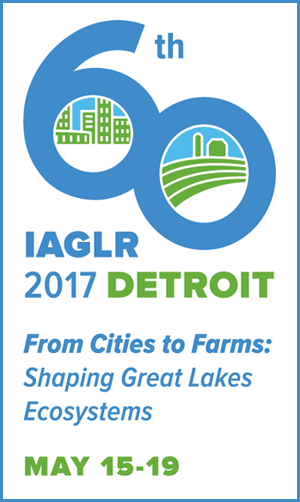
The 60th annual Conference on Great Lakes Research was held in Detroit, Michigan, on May 15 -19, 2017. Credit: International Association for Great Lakes Research.
The International Association for Great Lakes Research's (IAGLR) annual Conference on Great Lakes Research showcases the latest findings on the Great Lakes and other large lakes around the world. This year's conference, held last month in Detriot, Michigan, highlighted a range of NCCOS research, including:ecological forecasting, remote sensing, habitat mapping, modeling, harmful algal blooms, chemical contaminants, nutrients, invasive species, and hypoxia.
Below are the abstracts of the presentations and posters NCCOS scientists and their sponsored researchers contributed to the conference (note: Individual abstracts are no longer available. Please search for the abstracts listed below at this website).
Aquatic Invasive Species
The Great Lakes Aquatic Nonindigenous Species Information System Watchlist
Update on the Great Lakes Aquatic Nonindigenous Species Information System (GLANSIS)
Contaminants: Mussel Watch
Great Lakes Mussel Watch: Initiation of Effects-based Monitoring of Contaminants of Emerging Concern
Habitat Mapping
Using LIDAR Surveys to Map Habitats and Archaeological Sites in Western Lake Michigan
Harmful Algal Blooms: Forecasting
Combining Advanced Technologies to Develop an Early Warning System for HABs in Western Lake Erie
Relationships Between Field and Satellite Estimates of Cyanobacterial Bloom Severity in Western Lake
Use of Climate Forecasting System Forcings to Improve Lake Erie Harmful Algal Bloom Bulletin
Variability in Cyanobacterial Bloom Biomass in Saginaw Bay
Harmful Algal Blooms: Impacts, Mitigation, & Monitoring
Impacts of Lake Erie Harmful Algal Blooms on Larval Fish Abundance and Walleye Year-Class Strength
The mlr Pathway for Microcystin Degradation May Not be Relevant in Lake Erie and Lake Tai
Monitoring for Paralytic Shellfish Toxins in the Great Lakes: Challenges and Improvements
Hypoxia Forecasting
Lake Erie Hypoxia Forecasting for Public Water Systems Decision Support
Modeling Dissolved Oxygen Dynamics Near Drinking Water Intakes in the Central Basin of Lake Erie
Additional post-conference information can be found here.
For more information, contact Felix.Martinez@noaa.gov or Richard.Stumpf@noaa.gov.
 Official websites use .gov
A .gov website belongs to an official government organization in the United States.
Official websites use .gov
A .gov website belongs to an official government organization in the United States. Secure .gov websites use HTTPS
A lock or https:// means you’ve safely connected to the .gov website. Share sensitive information only on official, secure websites.
Secure .gov websites use HTTPS
A lock or https:// means you’ve safely connected to the .gov website. Share sensitive information only on official, secure websites.